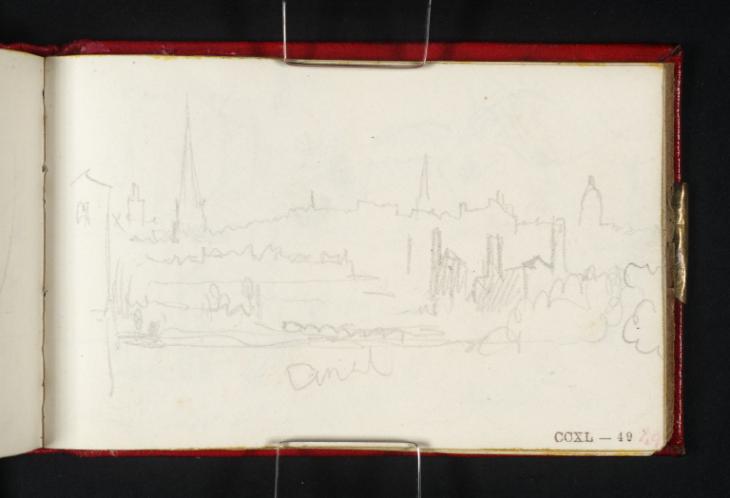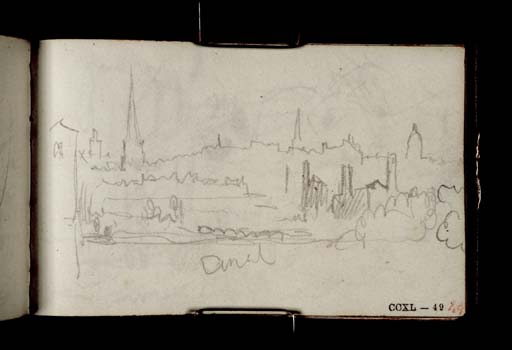Joseph Mallord William Turner Birmingham, with a Canal in the Foreground 1830
Image 1 of 2
Joseph Mallord William Turner,
Birmingham, with a Canal in the Foreground
1830
Joseph Mallord William Turner 1775–1851
Folio 49 Recto:
Birmingham, with a Canal in the Foreground 1830
D22415
Turner Bequest CCXL 49
Turner Bequest CCXL 49
Pencil on white wove paper, 68 x 110 mm
Inscribed by Turner in pencil ‘Canal’ bottom centre
Inscribed by John Ruskin in red ink ‘49’ bottom right
Stamped in black ‘CCXL – 49’ bottom right
Inscribed by Turner in pencil ‘Canal’ bottom centre
Inscribed by John Ruskin in red ink ‘49’ bottom right
Stamped in black ‘CCXL – 49’ bottom right
Accepted by the nation as part of the Turner Bequest 1856
Exhibition history
2003
Turner’s Britain, Gas Hall, Birmingham Museums & Art Gallery, November 2003–February 2004 (114, reproduced, as ‘View of Birmingham’).
References
1909
A.J. Finberg, A Complete Inventory of the Drawings of the Turner Bequest, London 1909, vol.II, p.739, CCXL 49, as ‘Do. [i.e. ditto: Dudley] with “Canal.”’.
1974
Martin Butlin, Andrew Wilton and John Gage, Turner 1775–1851, exhibition catalogue, Royal Academy, London 1974, p.122 under no.426, as a Dudley subject.
1979
Eric Shanes, Turner’s Picturesque Views in England and Wales 1825–1838, London 1979, p.156, as a Dudley subject.
1990
Frank Milner, J.M.W. Turner: Paintings in Merseyside Collections: Walker Art Gallery; Sudley Art Gallery; Williamson Art Gallery; Lady Lever Art Gallery; Liverpool University Art Gallery, Liverpool 1990, pp.53, 54, 55 under no.26, reproduced, as ‘Study for “Dudley” possibly taken from Tipton inscribed “Canal”’.
2003
James Hamilton, Turner’s Britain, exhibition catalogue, Gas Hall, Birmingham Museums & Art Gallery 2003, pp.15, 150, 203 no.114, pl.124, reproduced on front endpapers.
Previous commentators have taken this to be a Dudley view, like many on adjacent pages, but James Hamilton seems correct in his identification of this as a Birmingham subject;1 as part of unpublished Turner research informed by local knowledge, Dr Bernard Richards has confirmed this.2 Folios 45 recto and 47 recto (D22407, D22411) may also show Birmingham. The key landmark is the tall dome on the right, apparently that of St Philip’s Church (later Birmingham Cathedral). The church spires are probably St Martin’s-in-the-Bullring on the left, and the lost Christ Church on the skyline near the centre. Their alignment is similar in a drawing in the contemporary Kenilworth sketchbook (Tate D22023; Turner Bequest CCXXXVIII 26a), showing Birmingham from the east, and the viewpoint here may be in the middle distance there, making Turner’s ‘Canal’ the Warwick and Birmingham. Later developments preclude a clear prospect today. As Hamilton notes, the ‘detail in these studies is spare, but there is an intensity of expression in the drawings of church spires and towers of the two towns [Birmingham and Dudley], and of the dirty and heavy industrial equipment lying about.’3
Matthew Imms
August 2013
How to cite
Matthew Imms, ‘Birmingham, with a Canal in the Foreground 1830 by Joseph Mallord William Turner’, catalogue entry, August 2013, in David Blayney Brown (ed.), J.M.W. Turner: Sketchbooks, Drawings and Watercolours, Tate Research Publication, September 2014, https://www


